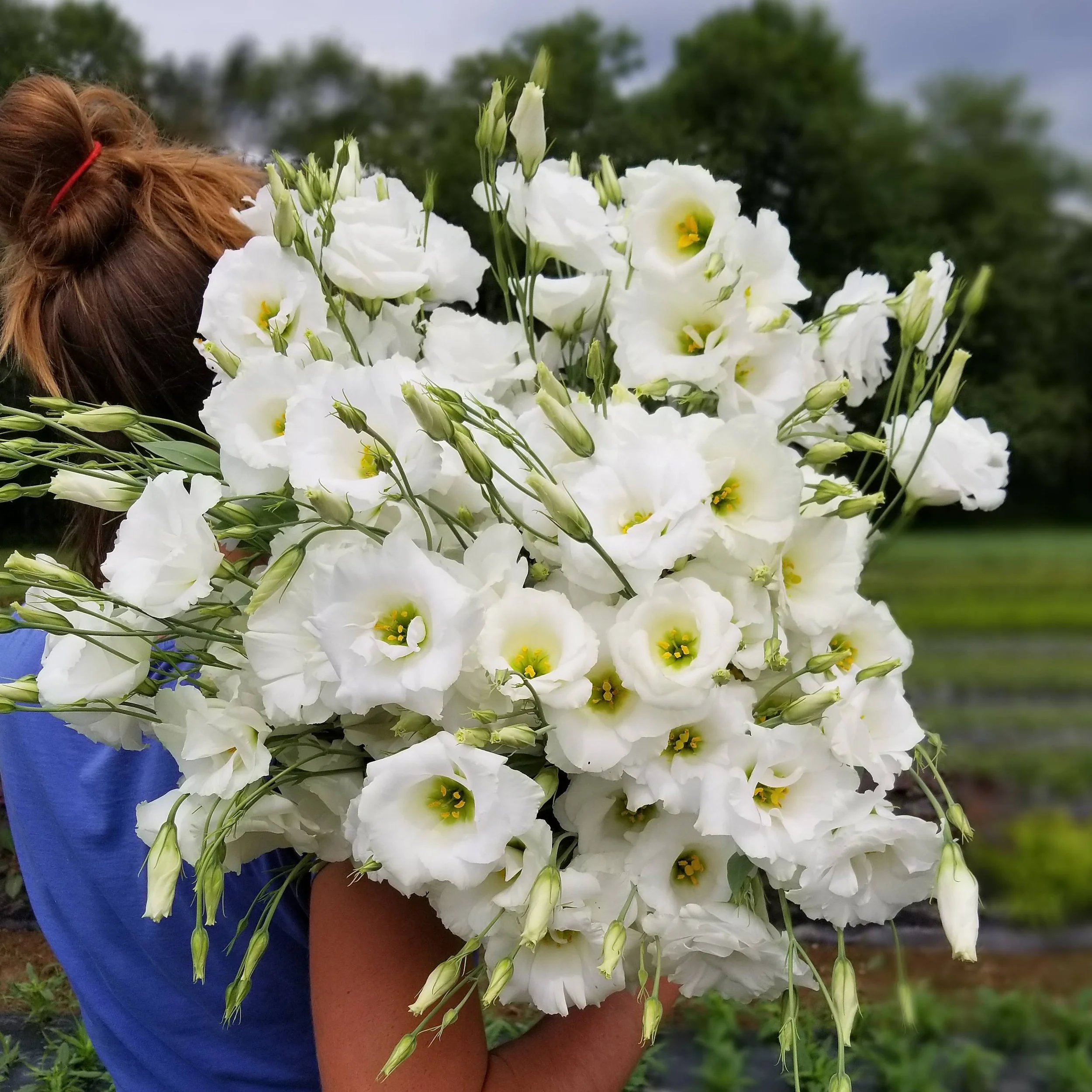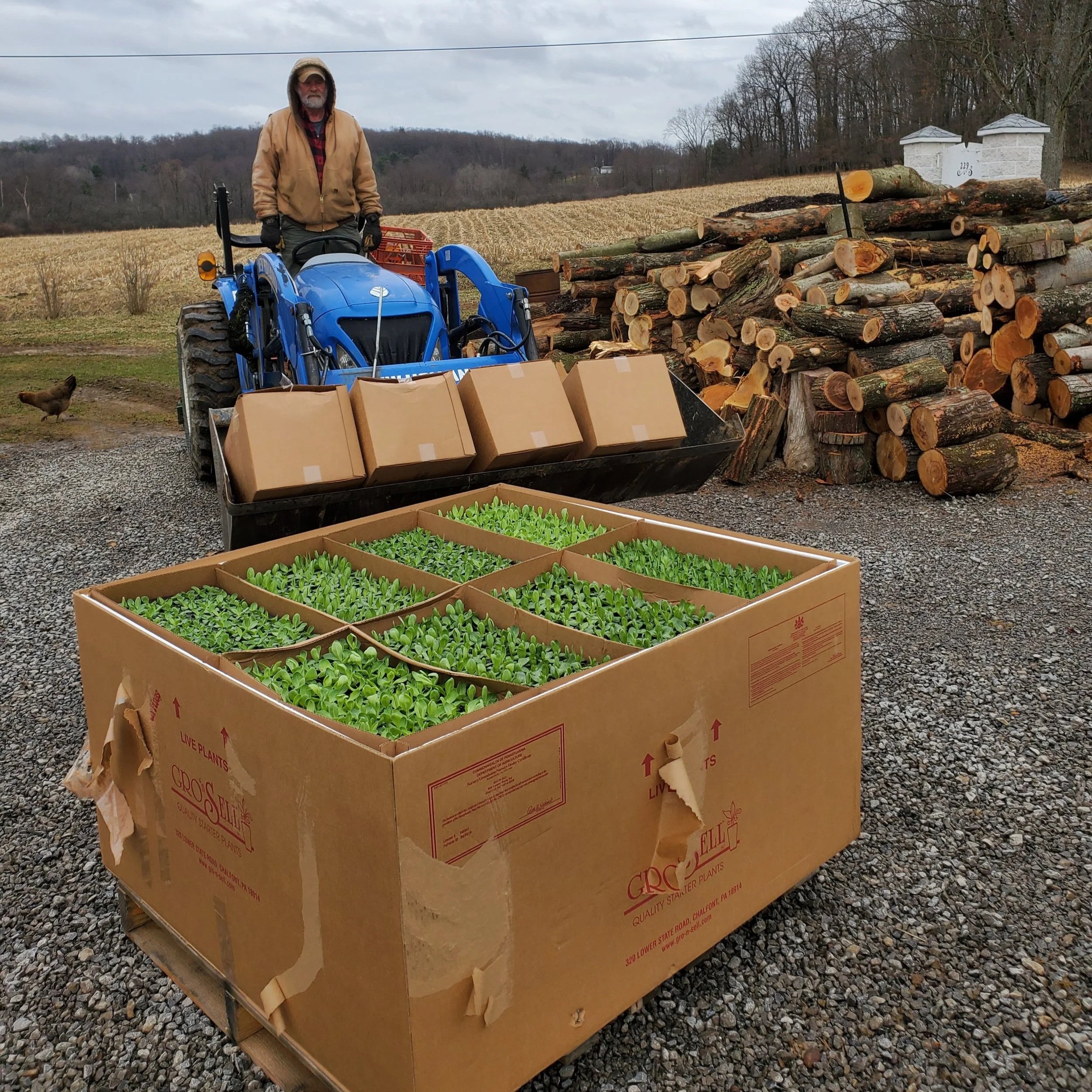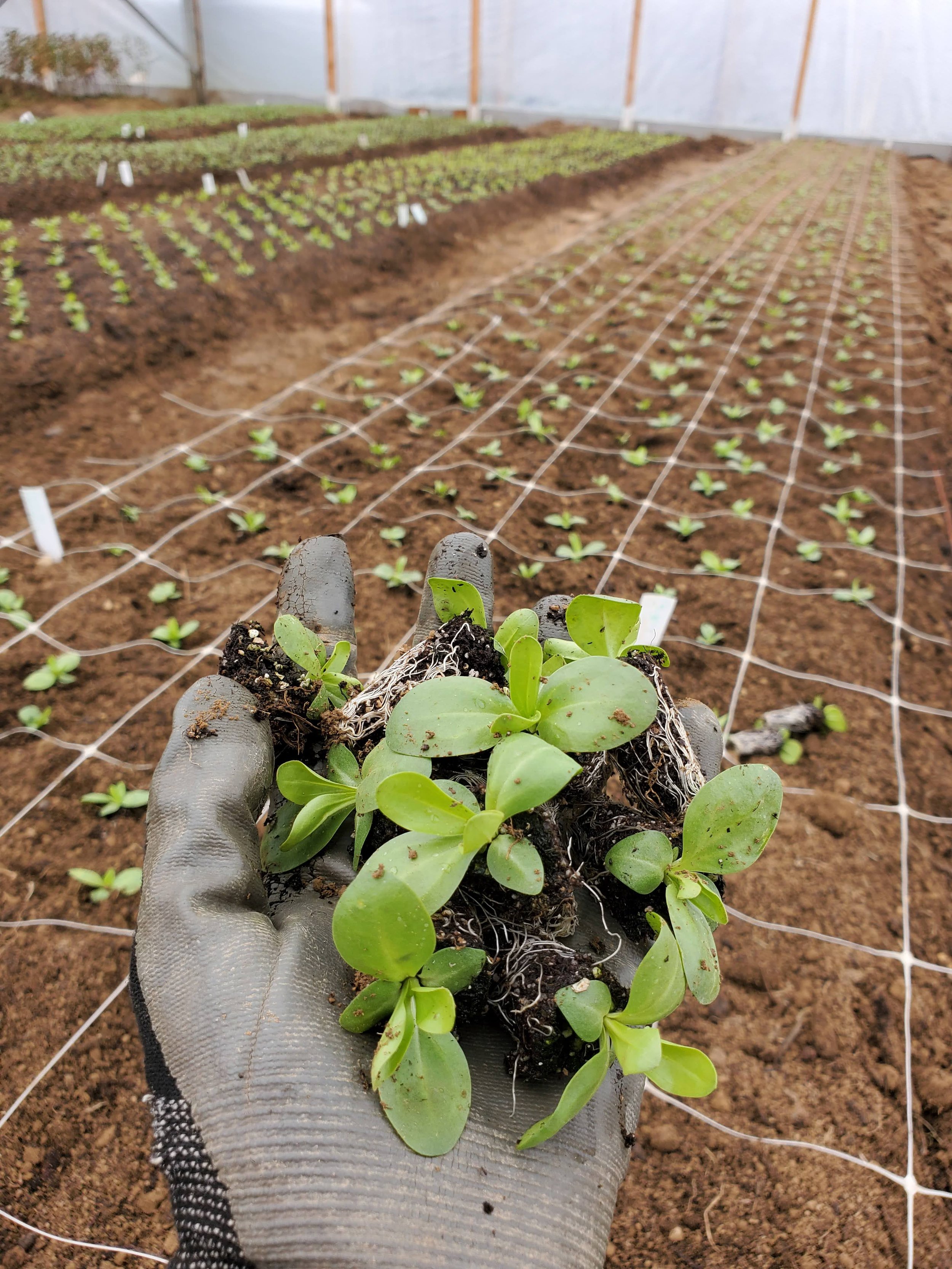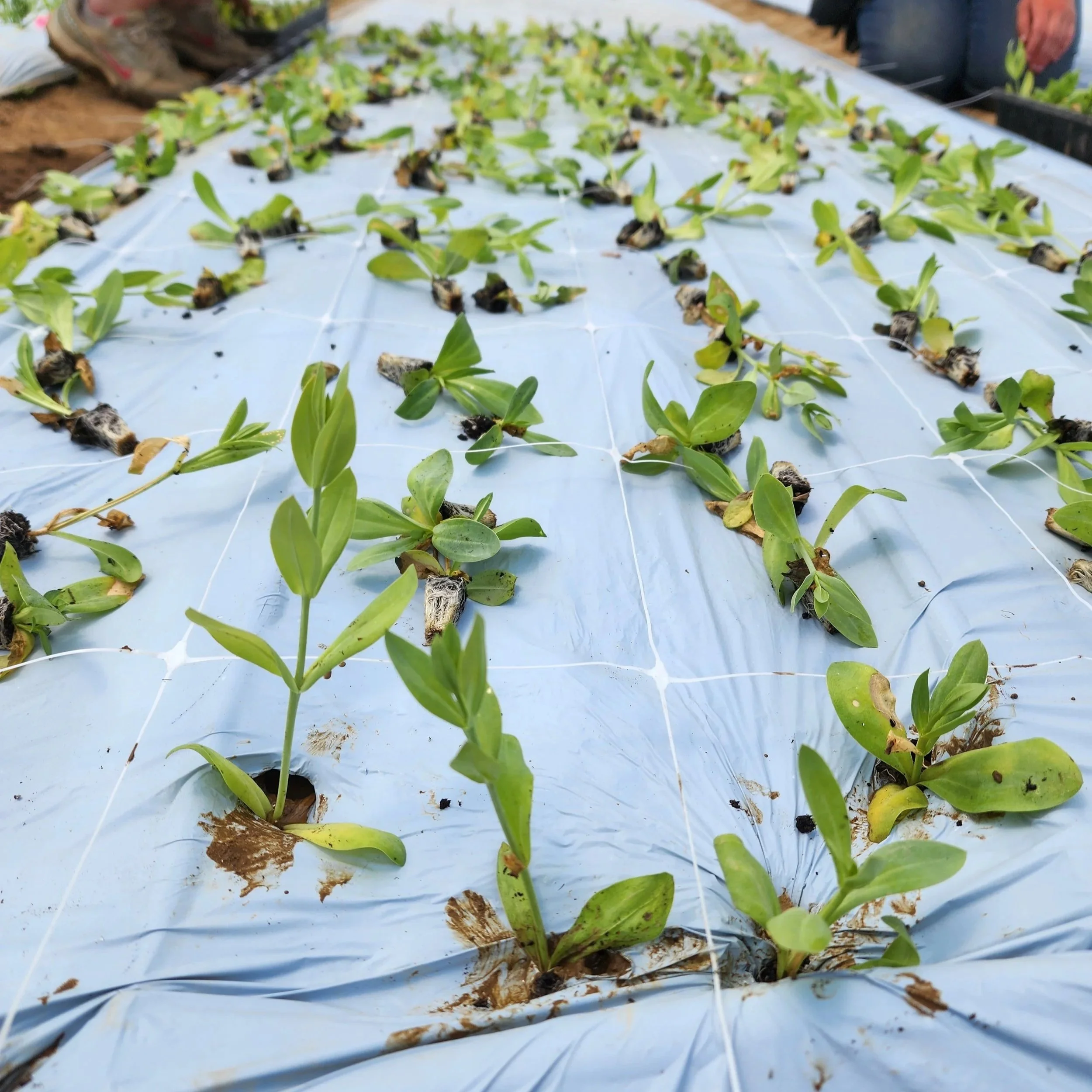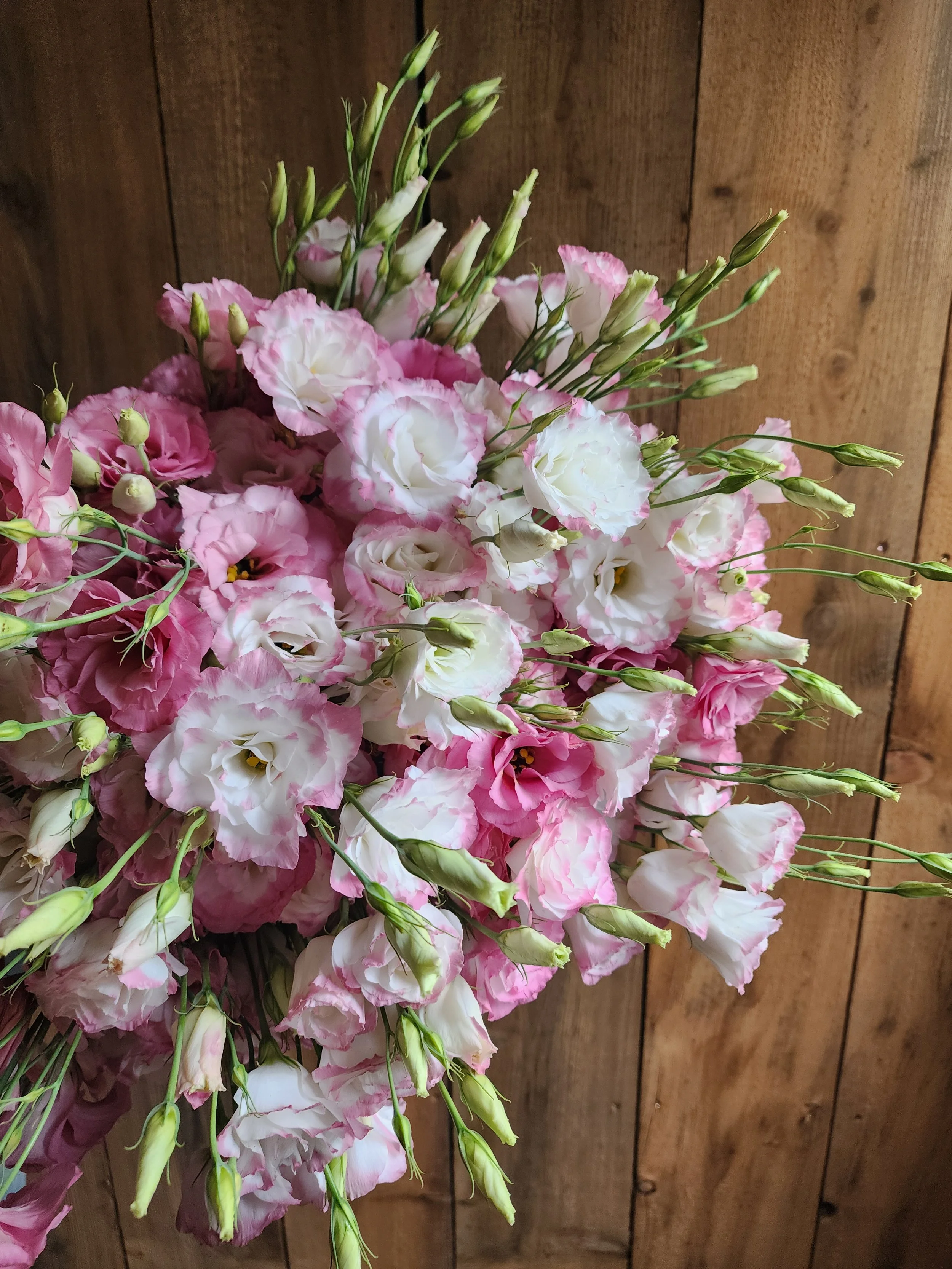Growing Lisianthus: What We’ve Learned (and Keep Learning)
If there’s one flower that stops people in their tracks in mid-summer, it’s lisianthus. Delicate but long-lasting, it’s the star of our July and August bouquets—and one of the most rewarding flowers we grow.
Lisianthus Quick Guide
Hardiness: Annual in most climates
Planting Time: Early spring (can handle light frost)
Spacing: 2–3 plants per 6" square
Watering: Deeply once a week after established
Support: Netting required for straight stems
Vase Life: 10–14 days
How We Grow Lisianthus at Goose Creek Gardens
Lisianthus is one of our absolute favorite flowers here on the farm. By late July and early August, they take center stage in our mixed grocery store bouquets, adding elegance, charm, and a soft, romantic feel. They have a long vase life, come in an incredible range of colors and styles, and—truthfully—make it hard to choose which varieties to grow each season.
If you’ve ever wondered how to grow lisianthus, I’ll walk you through our process, what’s worked for us, and a few lessons learned along the way.
Why We Don’t Start Lisianthus from Seed
Lisianthus trays neatly tucked in for shipping.
We get asked all the time: “How do you grow lisianthus from seed?”
Here’s the truth—we don’t. And we never have.
Lisianthus seeds take a very long time to germinate and grow—usually started in December or January for the upcoming season. That’s a 12-week (or longer) commitment before the plants are even ready to bump up to the next size cell. For us, the idea of heating greenhouses in the middle of snow season just doesn’t make sense. I like having a short winter break, even if it’s only a week or two, and starting lisianthus from seed would take that away.
Can it be done? Absolutely. But for our farm, ordering plants from a professional grower is the smarter choice.
Ordering Our Lisianthus Plugs
We place our lisianthus orders almost a year in advance—usually when that year’s crop is in bloom. Farmers really do live in the future, always planning for next season.
We buy the smallest plug trays we can, which is usually the best value. My go-to is the 392-count tray. These tiny plugs arrive healthy, uniform, and ready to grow thanks to the specialized care they’ve received from the nursery.
Lisianthus arriving to the farm in the spring.
Sometimes the trays show up a bit jumbled. This is when we would pot the plant into a larger tray. With a good drink of water they recover quickly.
Planting Day – Always Exciting!
Planting lisianthus plugs.
Lisianthus usually arrives for us between early March and mid-April, depending on availability and when we want to plant. The great thing about lisianthus is that they can handle the cold, so we can plant them directly into the ground from those tiny cells.
If the beds aren’t ready, we sometimes bump them up into a larger tray (like a 72 or 50 count) until it’s planting time. When planting directly from the 386 trays, we water them in well every day until their roots are established.
We plant most of ours in unheated high tunnels, but we’ve also had success growing them outside in the field.
How We Plant Lisianthus
We plant into beds covered with biodegradable plastic mulch, with irrigation lines underneath. The mulch helps retain moisture and suppress weeds—though lisianthus still needs consistent weeding.
Our planting guide is the netting we’ll later use for support. The squares on the netting are 6 inches wide, and we plant two plugs per square. This close spacing encourages tall, straight stems—perfect for bouquets.
Weed control is the hardest part. Lisianthus grows slowly at first, but weeds grow fast (especially when you’re watering and fertilizing). We start weekly weeding about two weeks after transplanting to keep them from getting out of control.
2 lisianthus plugs per one 6inch square.
Watering and Fertilizing
Once lisianthus roots are established, we give them a deep watering about once a week. The plastic mulch helps prevent evaporation, keeping the soil moist longer.
We also fertilize every other week with a foliar feed to keep them strong and healthy.
A high tunnel freshly planted with lisianthus.
Netting and Support – A Must for Lisianthus
One of the biggest lessons I’ve learned: lisianthus absolutely needs support once it starts blooming.
When planting, we lay the netting flat on the bed and then pull it up as the plants grow. If you wait too long, the blooms can become too heavy, and you’ll come in one morning to find your plants toppled over into the walkways. It’s not fun—and it’s preventable.
We use wooden tomato stakes or fence posts every 4–5 feet to keep the netting taut and in place. A crooked stem is nearly impossible to use in bouquets, so support is key.
Purple lisianthus ready to be harvested.
Harvesting – The Best Part!
Harvesting lisianthus is pure joy. When the first blooms open, we wait until one is starting to fade before cutting—that encourages more buds to open on each stem. We’ve had stems with up to 15 blooms before!
When we sold lisianthus to florists, we bunched them as 20 blooms per bunch with at least five stems. These days, since we grow mostly for mixed grocery bouquets, we plant them even closer—three plants per 6-inch square—which produces fewer blooms per stem but taller, more uniform stems.
Our team harvesting lisianthus.
Can You Get a Second Flush?
In our zone (6a), a second flush of blooms before frost is tricky. Our first frost usually arrives around October 10th, and by then the plants haven’t put on enough growth for another round of flowers.
We’ve only had one truly successful second bloom, and that was in a heated tunnel where we had fresh blooms into late October and November. This year, I’m going to make a real effort to keep them watered and fertilized after the first harvest to see if we can coax that second flush—because who wouldn’t love lisianthus for Thanksgiving arrangements?
Pink lisianthus ready to be harvested.
Lessons Learned
Plant closer for longer stems
Don’t delay pulling up your netting
Weed early and often
Order plugs early—really early
Pink Picotee lisianthus
Final Thoughts
Lisianthus is a little finicky and can be slow to grow, but it’s worth every bit of effort once those gorgeous blooms appear. With the right planning, support, and care, they can become one of the most rewarding flowers in your cutting garden.
If you’ve been thinking about adding lisianthus to your flower lineup, I say go for it—you might just fall in love like we did.

